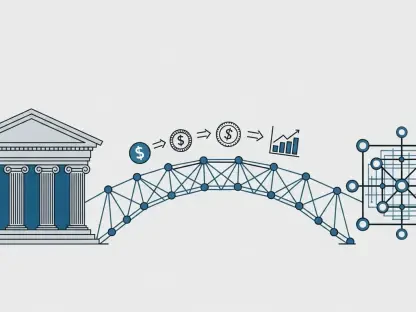Decentralized Finance (DeFi) has revolutionized the financial sector by offering a peer-to-peer alternative to traditional financial intermediaries and transactions. As we move into 2024, several emerging trends and innovations are set to shape the future of DeFi, enhancing its usability, accessibility, and appeal. This article delves into these prominent trends, providing a detailed and cohesive narrative that captures key insights and emerging themes in the DeFi sector.
Perpetual Liquidity Pools (PLPs)
Continuous Liquidity and Efficiency
One of the foremost innovations gaining traction in the DeFi space is Perpetual Liquidity Pools (PLPs). Unlike traditional liquidity pools that necessitate periodic rebalancing to maintain liquidity, PLPs provide continuous, sustained liquidity. This marks a significant advancement in liquidity management, enhancing the efficiency of decentralized exchanges (DEXs) by reducing slippage and minimizing transaction costs. Perpetual liquidity ensures that trades can occur seamlessly and with less price impact, making DEXs far more reliable and user-friendly.
PLPs are not just improving liquidity within the scope of individual exchanges but are progressively setting new standards across the DeFi landscape. As they eliminate the need for constant manual intervention, these pools can maintain a steady liquidity rate, thereby improving market efficiency. By reducing the barriers to liquidity provision, PLPs empower a broader spectrum of users to participate in the DeFi economy, leading to a more democratized and decentralized financial system. This innovation is not only transformative for liquidity management but is also vital for the overall health and stability of DeFi markets.
Impact on Market Volatility
With the growing adoption of PLPs in various DeFi projects, the sector is poised to experience increased liquidity and reduced market volatility. This ensures a more robust and efficient trading environment, making DeFi platforms more attractive to both new and experienced users. The continuous liquidity provided by PLPs is a game-changer, setting the stage for more stable and predictable trading experiences. Besides, the improved liquidity conditions are likely to attract a more diverse user base, including institutional investors seeking to capitalize on the efficiency and reliability of decentralized markets.
The reduction of market volatility due to PLPs has broader implications for the DeFi ecosystem. As price swings and excessive slippage become less prevalent, user confidence is likely to increase, paving the way for greater market participation. Additionally, the predictability in trade outcomes encourages larger transaction volumes, which further stabilizes the market. Projects leveraging PLPs are also likely to see enhanced user retention as the platform’s reliability becomes evident, thereby fostering growth and maturity within the DeFi space. The utilization and subsequent success of PLPs signal a promising future where market stability and user engagement go hand in hand.
Intents-Based Architecture
Simplifying User Experience
Another groundbreaking development in DeFi is the shift towards intents-based architecture. This paradigm shift redefines user interaction with DeFi protocols by allowing users to specify their desired outcomes instead of detailing every transaction aspect. The protocol then handles the complexities, simplifying the user experience and automating intricate processes. This model is particularly advantageous for those who are new to DeFi, as it reduces the cognitive load and technical barriers associated with using decentralized financial services.
Intents-based architecture fundamentally changes the way users engage with DeFi applications. By focusing on what users want to achieve rather than how they achieve it, this approach makes DeFi applications more intuitive and accessible. For instance, a user wishing to swap a cryptocurrency for another at the best possible rate can simply specify this intent, and the platform will navigate through the best possible routes and processes to fulfill the request. This leads to a more streamlined user experience, which is crucial in attracting a broader audience and driving the mass adoption of DeFi.
Lowering Barriers to Entry
This user-friendly approach lowers the barrier to entry, making DeFi more accessible to a wider audience. By enhancing the scalability and efficiency of DeFi protocols, intents-based architecture has the potential to lead to broader adoption and more seamless participation in decentralized financial services. This innovation is crucial for attracting new users who may have been intimidated by the complexities of traditional DeFi interactions. As DeFi services become more user-centric, they can appeal to both tech-savvy individuals and those with limited technical knowledge.
Moreover, intents-based architecture democratizes access to sophisticated financial services that were previously accessible only to a niche audience. By automating and simplifying the processes behind the scenes, these protocols allow users to focus on achieving their financial goals without the need for extensive technical know-how. This shift not only broadens the user base but also enhances user retention, as the experience becomes more rewarding and less cumbersome. Additionally, the increased efficiency and scalability offered by intents-based architecture can lead to lower operational costs, making DeFi services more affordable and appealing.
Points and Airdrop Meta
Incentivizing User Participation
Incentivizing user participation through points and airdrops has become a prevalent strategy within DeFi ecosystems. These mechanisms reward users for their engagement, driving higher activity and liquidity for the projects. By functioning as critical drivers for user growth and engagement, points and airdrops are essential in fostering a vibrant and participative DeFi community. Users are more likely to engage with a platform that offers tangible rewards for their participation, creating a mutually beneficial ecosystem where both projects and users thrive.
The strategy of points and airdrops also plays a significant role in project development and visibility. Startups and emerging projects can utilize these incentives to attract early adopters and create an initial user base. This not only boosts the liquidity and activity on the platform but also helps in building a community of dedicated users. Furthermore, these incentive mechanisms can be tailored to promote specific behaviors, such as staking, trading, or providing liquidity, thus aligning user actions with project goals and ensuring a dynamic and active ecosystem.
Sustained User Growth
As these incentive structures evolve, the DeFi ecosystem is expected to witness sustained user participation and growth. This further enriches the overall ecosystem, creating a more dynamic and interactive environment for users. The continuous development of points and airdrop strategies will play a significant role in maintaining user interest and activity in DeFi projects. The anticipation of rewards ensures that users remain engaged over the long term, contributing to the stability and expansion of the platform.
Sustained user growth driven by effective incentive strategies also leads to network effects that benefit the entire DeFi ecosystem. As more users join and engage with DeFi platforms, the liquidity, stability, and overall functionality of these networks improve. This, in turn, attracts even more users, creating a positive feedback loop that fosters continuous growth and innovation. Projects that successfully leverage points and airdrops can not only retain their user base but also expand it, ensuring long-term success and relevance in the competitive DeFi landscape.
Liquid Staking Protocols
Enhancing Staking Flexibility
Staking, a fundamental aspect of many DeFi projects, is being revolutionized by liquid staking protocols. Traditionally, staking requires users to lock up their assets, rendering them unusable for other purposes. Liquid staking protocols address this limitation by allowing users to remain liquid while earning staking rewards. This innovative approach provides users with the dual benefit of earning staking income without sacrificing the liquidity of their assets. As a result, stakers have the flexibility to utilize their assets for other DeFi activities, such as lending or trading, expanding their potential for returns.
This newfound flexibility is pivotal for the DeFi ecosystem, encouraging more users to participate in staking without fear of missing out on other opportunities. Liquid staking protocols create a more dynamic financial environment where assets can be put to multiple uses simultaneously. This enhances the overall efficiency and productivity of the DeFi space, as assets are utilized to their fullest potential. Moreover, the increased participation in staking activities bolsters the security and stability of the underlying blockchain networks, as more assets are committed to maintaining network integrity.
Increased Usability of Staked Assets
This means stakers can leverage their assets for other DeFi activities, such as lending or trading, thereby increasing the flexibility and usability of staked assets. This innovation is set to drive better participation in staking, contributing to the security and stability of blockchain networks. By removing the constraints typically associated with staking, liquid staking protocols enable users to maximize the utility and profitability of their assets. This makes staking a more attractive option for both new and seasoned DeFi participants.
The increased usability of staked assets also has broader implications for the DeFi market. As users realize the benefits of liquid staking, more assets are likely to flow into staking protocols, enhancing the overall liquidity and robustness of the DeFi ecosystem. This, in turn, can lead to more innovations and developments within the space, as increased participation and liquidity create fertile ground for new projects and applications. Furthermore, liquid staking protocols can attract institutional investors who seek liquidity and yield, driving even greater adoption and growth in the DeFi sector.
Cross-Chain Bridging
Facilitating Interoperability
Cross-chain bridging represents one of the most promising developments for the future of DeFi. It enables seamless communication and asset flow between different blockchain networks, supporting the interoperability essential for DeFi ecosystems to scale and integrate. By facilitating the integration of a wide range of assets and services, cross-chain bridging enhances user experience and promotes innovation within the DeFi space. The ability to move assets across different blockchains without friction is crucial for the growth and maturation of DeFi, as it allows users to access a broader range of financial products and services.
The interoperability provided by cross-chain bridges is critical in breaking down the silos that currently exist within the blockchain space. It allows for a more interconnected and fluid market where users can freely move their assets and interact with multiple DeFi platforms. This not only broadens the possibilities for users but also fosters collaboration and innovation among DeFi projects. The enhanced interoperability supports the development of more complex and sophisticated financial products, providing users with a richer and more versatile financial ecosystem.
Promoting Innovation
Cross-chain bridging allows various DeFi protocols to complement each other, offering diversified and complex financial services to users. This development is crucial for the growth and maturation of the DeFi ecosystem, as it enables the creation of more sophisticated and interconnected financial products. The ability to move assets and data across different blockchains seamlessly is a key factor in the future success of DeFi. This interconnectedness opens up new avenues for innovation, as developers can build applications that leverage the strengths of multiple blockchain networks.
The promotion of innovation through cross-chain bridging is set to transform the DeFi landscape. As different protocols and platforms become more integrated, users will have access to a wider array of services and opportunities. This fosters a competitive environment where projects must continuously innovate to stay relevant, driving technological advancements and improving user experiences. Additionally, the seamless flow of assets and information across blockchains can lead to the development of entirely new financial models and use cases, further expanding the horizons of what is possible within the DeFi space.
Real-World Assets (RWA)
Tokenization of Real-World Assets
The tokenization of real-world assets (RWA) is set to be a game-changer for DeFi. By integrating assets like real estate or commodities into DeFi platforms, users can access stable yields and secure investment opportunities. This development is likely to attract traditional investors seeking safer investments, potentially driving broader adoption of DeFi by mainstream financial institutions. Tokenizing real-world assets involves converting tangible assets into digital tokens that can be traded or used within the DeFi ecosystem, thus bridging the gap between traditional finance and decentralized finance.
The tokenization of RWAs promises to bring greater stability and legitimacy to the DeFi space. As valuable, tangible assets are integrated into DeFi platforms, the appeal of these platforms to conservative and institutional investors increases. This not only diversifies the types of assets available within the DeFi ecosystem but also enhances the overall market stability by bringing in assets that are less volatile compared to typical cryptocurrencies. Furthermore, the tokenization of RWAs can lead to increased liquidity for traditionally illiquid assets, providing more flexibility and opportunities for investors.
Attracting Traditional Investors
Decentralized Finance (DeFi) has completely transformed the financial sector by eliminating the need for traditional banking intermediaries and enabling peer-to-peer transactions. As we head into 2024, several emerging trends and innovations are poised to further revolutionize DeFi. These developments promise to enhance its usability, accessibility, and overall appeal, making it more viable and attractive for a broader audience.
The future of DeFi is being shaped by various key trends. One of the primary trends is the integration of advanced technologies, such as blockchain and smart contracts, which are making transactions more secure and transparent. Additionally, the rise of decentralized exchanges (DEXs) is providing users with more control over their funds and reducing the risk of centralized exchange failures.
Another significant trend is the increased focus on regulation and compliance within the DeFi space. As governments and regulatory bodies take a closer look at DeFi, there’s a push to develop frameworks that ensure consumer protection while fostering innovation. Moreover, there’s a notable shift towards improving user experience through more intuitive interfaces and enhanced accessibility, bringing DeFi closer to mainstream adoption.
These trends and innovations highlight an exciting future for DeFi, making it a pivotal area to watch as we move further into 2024. The evolution of DeFi has just begun, and its implications for the global financial landscape could be profound.









